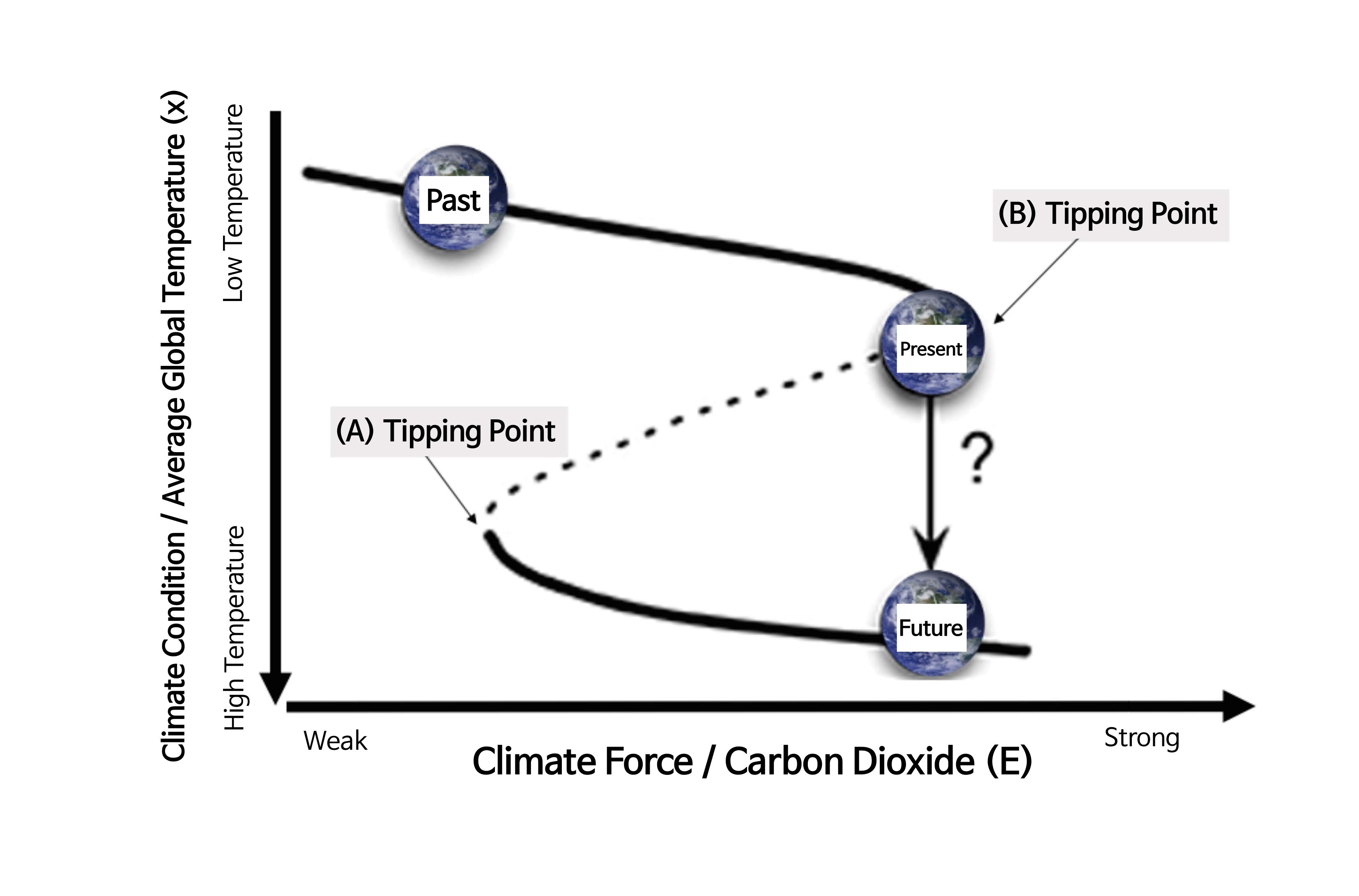- Climate Crisis: Has the Tipping Point Already Passed? June 30, 2021
-
by Professor An Soon-Il, Department of Atmospheric Sciences

The Climatological Significance of the Paris Agreement
The rise in the global temperature, a phenomenon that has emerged after the Industrial Revolution, is known to be taking place most rapidly since humanity appeared on Earth. It has been scientifically proven to be caused by the emission of artificial greenhouse gases. By signing the Paris Agreement in 2015, politicians from different parts of the world formed a consensus on the urgency to respond to climate change. They would aim to limit global warming to well below 2℃, preferably to 1.5℃ compared to pre-industrial levels. Although these encouraging actions were tarnished by the United States' Trump administration's declaration of withdrawal from the Paris Agreement, now it is expected that most countries that pledged to the agreement will continuously work towards meeting the goal again, as the Biden administration later declared the United States' return.
However, aside from whether it is feasible to change the direction of politics, economies, and citizens' daily lives, the question remains whether it would be scientifically possible to limit global warming to 1.5 to 2 degrees Celsius by achieving a reduction plan for fossil fuel by 2050.
Can Global Warming be Contained Below 1.5-2℃?
Over the last century, the amount of greenhouse gases in the Earth's atmosphere has increased dramatically compared to the natural growth rate in the past few hundred thousand years. The average global temperature derived from this is reported to rise by about 1 degree Celsius compared to before the Industrial Revolution. However, the problem arises because this 1-degree rise is not directly due to the currently recorded concentration of carbon dioxide (410 ppm; 280ppm before the Industrial Revolution). This is due to the relatively slow response rate of the global climate system to a given climate force (e.g., carbon dioxide). For instance, solar radiation reaching the Korean Peninsula is the strongest in late June, but the actual temperature is the highest in late July. Climate model experiences indicate that even if the concentration of carbon dioxide in the atmosphere is reduced to the pre-industrial values, the temperature higher than that in the pre-Industrial Revolution will last for hundreds of years. This is attributed to the slow response of climate systems, such as oceans, to changes in the level of carbon dioxide and the release of heat energy accumulated in the oceans during the increase in carbon dioxide.
After all, carbon neutrality cannot solve the problem of global warming at once, meaning that we would have to live for a long time on a hot Earth where the temperature has risen at least 1.5-2℃. In addition, climatologists predict that climate overshooting may occur around 2050, the year that carbon neutrality will be achieved, suggesting a higher temperature increase than expected 1.5-2.0℃.
The prospects suggested so far for the future of climate are considered reliable predictions with relatively low uncertainty. However, a loom of tipping points is emerging as a possibility; though the uncertainty is high, such a possibility cannot be ruled out.

(Photography by Andrea Schettino / www.pexel.com)
What is a "Tipping Point?"
A "tipping point" (or a critical point) is a concept used frequently across different areas of studies, including natural sciences and social sciences. It is defined as "a series of small changes that are significant enough to cause a larger, more important change." Phenomena related to the concept of the tipping point that can be commonly witnessed include landslides and avalanches. Tipping points in the climate system are also very rapid and can result in significant changes. That is, when climate change passes a tipping point, it will transform into a completely different climate system that is not visible in the current climate conditions.
If the current state of the climate is referred to as a "quasi-stable equilibrium state," the tipping point corresponds to the inflection point for the transformation to different equilibrium states. Imagine two valleys on the other side of the mountain; the two valleys can be considered different climate equilibrium states, and the top of the hill is a tipping point. For example, if a ball placed in one valley is forced to climb to the top of the mountain (the tipping point), the ball will then easily descend to the other valley. Once again, moving the ball back to the original valley will require a special force. Therefore, recovery will become highly difficult after passing the tipping point, with the significant changes it brings about.
What are the Tipping Elements Present in the Climate System?
Possible "tipping elements" in the current climate system include the demise of Arctic sea ice, the end of Greenland and West Antarctic glaciers, the extinction of permafrost and tundra, rapid changes in the Sahara and El Niño, the devastation of the Amazon rainforest and temperate forests in the Northern Hemisphere, the disappearance of coral reefs, and the reversal of the Atlantic Meridional Overturning Circulation (AMOC). Among them, Arctic sea ice and coral reefs are predicted to be unable to save from their major changes even if the Paris Agreement succeeds. And significant changes are also detected in the permafrost and tundra, but it is unclear how the changes will proceed due to the lack of observation and research.
AMOC, in particular, is a vast circulation that connects the entire Atlantic Ocean to the North and the South, transporting energy from the Tropics to the high latitude. The tipping for AMOC occurred at the age of the Ice Age about 20,000 years ago, when the melted water (freshwater) from the glaciers of North America flowed into the North Atlantic; the AMOC stopped circulating and caused temperatures in Europe and the rest of the northern hemisphere to drop sharply by about 10 degrees. This state lasted for 1,000 years and became known as the "Younger Dryas." Interestingly, over the past 100 years, temperatures in the northern hemisphere have increased by 2 to 3 degrees while temperatures in the North Atlantic have rarely increased, and AMOC is also known to have weakened.
Recently, research has emerged on tipping cascades, in which one tipping point can trigger other inter-related tipping points. This cascade is possible because tipping elements of the global climate system are organically connected to each other. Then, how is the occurrence of tipping possible?

How Does Tipping Occur?
To understand the principle of tipping occurrence, let's express climate change as a simple dynamic system equation.
dx/dt = f(x,λ) + S(t)
The equation above is the governing equation for the change in time (t) of any physical quantity x, where f is the internal process governing the change in this physical quantity, and S(t) is the external force. To simplify the problem, assume that S is a constant E that does not change over time. If the internal physics process equation is f(x,λ) = -λx + bx³, the dynamic system equation becomes the following deterministic equation.
dx/dt = -λx + bx³ + E
Assuming above that any physical quantity x is the average global temperature, and the external force E is the concentration of carbon dioxide in the atmosphere, the above dynamic equation becomes the average global temperature equation, from which the equilibrium average global temperature x̄ for the given carbon dioxide concentration E is obtained. In this case, since the rate of change in the equilibrium state is dx̄/dt = 0, the average global temperature equation for the equilibrium state becomes E = λx - bx̄³.
First, considering that the internal physical process is linear, i.e., b = 0, the average global temperature at equilibrium is x = E/λ, where λ is the reaction coefficient. In this case, the given E and the climate reaction x̄ are linearly proportional, and no tipping occurs. This time, consider the case where b = 1. In this case, the average global temperature in equilibrium with respect to a given E is determined from λx̄ - x̄³ = E. Graphically, this is the curve of the cubic equation as shown in the figure below: curve made by solid and dotted lines in the figure.

The curve in the above cubic equation shows that given the climate forces, the average global temperature in equilibrium can exist in one or three ways. That is, when the climate force (E) has a range of E<(A) or E>(B), the average global temperature in equilibrium exists as one value. However, if (A)<E<(B), the average global temperature in balance can have three values, i.e., multiple equilibria. Since the system in the dotted line of the graph is unstable and cannot maintain the equilibrium status, the Earth's average temperature in the real equilibrium can hold only two values. Starting from the Earth's previous climate equilibrium, let's slowly increase the concentration of carbon dioxide (E), a climate force, to the point (B). The graph shows that the average global temperature in equilibrium also gradually increases. If E is increased above (B), the stable equilibrium of the current climate system will deviate from the solid line that has been followed so far and will eventually find its stable solution on the solid line below.
Eventually, tipping occurs, and the temperature in the equilibrium undergoes a drastic change from the current Earth to that of the future. The problem is that even if climate forces are reduced, it is difficult to return to the current climate after its drastic changes. That is if the climate forces(E) are reduced from the solid line indicating the future Earth, the average global temperature in the equilibrium will undergo changes following the higher solid line; the climate conditions shown on the below solid line are maintained until E is reduced to the tipping point (A). Subsequently, if E is reduced below (A) point, tipping occurs again at (A) point and changes rapidly to the past Earth.
As seen above, tipping is represented by nonlinear properties of the climate system, and it exhibits irreversible features that make it difficult to return to the original state once tipping occurs. Therefore, preventing climate change from reaching the tipping points is essential in stopping a future climate crisis.

Conclusion
The most severe and urgent issue facing humanity today is climate change, and it is a task that must be addressed. However, suppose we approach the issue of climate change while maintaining our lives exactly the same. In that case, it is impossible to deviate away from the climate crisis, and the damage must be beyond imagination. Therefore, efforts must be made to achieve carbon neutrality by reducing the use of fossil fuels and forest destruction. Only through these earnest efforts can humankind escape from the climate crisis.
Recently, many cases have been suspected of reaching tipping points, such as sharp declines in the Arctic sea ice and West Antarctic glaciers. Although it is too early to conclude that tipping has occurred, it should not be overlooked that once tipping is detected, it is irreversible. There is an aviation term called "Point of No Return (PNR)." PNR refers to a point where the plane cannot go back to where it took off. It is a critical point arising from the lack of fuel or after the cost-benefit analysis. Since the issue of the climate crisis is directly related to the survival of humankind, the solution to escape from such a crisis should be decided in terms of cost and benefits unless it reaches a physically impossible position to return.
At this point, it is impossible to determine whether precisely the tipping point has already been reached. Still, the world will undoubtedly have to make efforts to escape the climate crisis to avoid greater disasters. Finally, I would like to conclude this article by quoting Dr. Stephen Hawking. "We are close to the tipping point where global warming becomes irreversible."
As a professor at the Department of Atmospheric Sciences, the College of Science, Professor An Soon-Il is also the Director of the Irreversible Climate Change Research Center and has been conducting research on irreversible climate change, tipping points, and drastic climate changes.
show mobile menu
mobile menu




